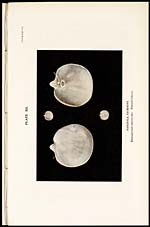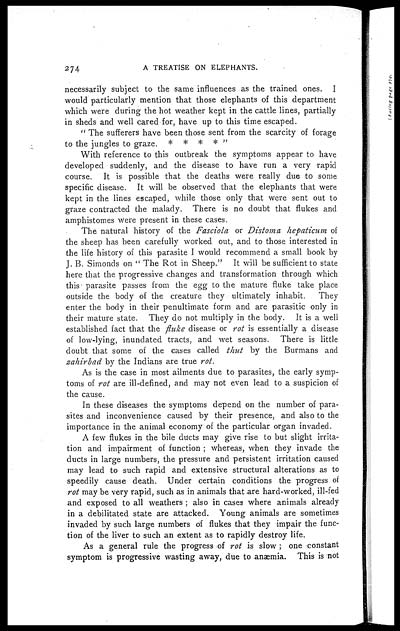Medicine - Veterinary > Veterinary diseases > Elephants and their diseases > Part IV - Non-infective diseases
(332) Page 274
(333) next ›››
Colour plate XII
Download files
Individual page:
Thumbnail gallery: Grid view | List view

274 A TREATISE ON ELEPHANTS.
necessarily subject to the same influences as the trained ones. I
would particularly mention that those elephants of this department
which were during the hot weather kept in the cattle lines, partially
in sheds and well cared for, have up to this time escaped.
" The sufferers have been those sent from the scarcity of forage
to the jungles to graze. * * * * "
With reference to this outbreak the symptoms appear to have
developed suddenly, and the disease to have run a very rapid
course. It is possible that the deaths were really due to some
specific disease. It will be observed that the elephants that were
kept in the lines escaped, while those only that were sent out to
graze contracted the malady. There is no doubt that flukes and
amphistomes were present in these cases.
The natural history of the Fasciola or Distoma hepaticum of
the sheep has been carefully worked out, and to those interested in
the life history of this parasite I would recommend a small book by
J. B. Simonds on " The Rot in Sheep." It will be sufficient to state
here that the progressive changes and transformation through which
this parasite passes from the egg to the mature fluke take place
outside the body of the creature they ultimately inhabit. They
enter the body in their penultimate form and are parasitic only in
their mature state. They do not multiply in the body. It is a well
established fact that the fluke disease or rot is essentially a disease
of low-lying, inundated tracts, and wet seasons. There is little
doubt that some of the cases called thut by the Burmans and
zahirbad by the Indians are true rot.
As is the case in most ailments due to parasites, the early symp-
toms of rot are ill-defined, and may not even lead to a suspicion of
the cause.
In these diseases the symptoms depend on the number of para-
sites and inconvenience caused by their presence, and also to the
importance in the animal economy of the particular organ invaded.
A few flukes in the bile ducts may give rise to but slight irrita-
tion and impairment of function ; whereas, when they invade the
ducts in large numbers, the pressure and persistent irritation caused
may lead to such rapid and extensive structural alterations as to
speedily cause death. Under certain conditions the progress of
rot may be very rapid, such as in animals that are hard-worked, ill-fed
and exposed to all weathers ; also in cases where animals already
in a debilitated state are attacked. Young animals are sometimes
invaded by such large numbers of flukes that they impair the func-
tion of the liver to such an extent as to rapidly destroy life.
As a general rule the progress of rot is slow ; one constant
symptom is progressive wasting away, due to anaemia. This is not
Set display mode to: Large image | Zoom image | Transcription
Images and transcriptions on this page, including medium image downloads, may be used under the Creative Commons Attribution 4.0 International Licence unless otherwise stated. ![]()
| India Papers > Medicine - Veterinary > Veterinary diseases > Elephants and their diseases > Non-infective diseases > (332) Page 274 |
|---|
| Permanent URL | https://digital.nls.uk/75193056 |
|---|



